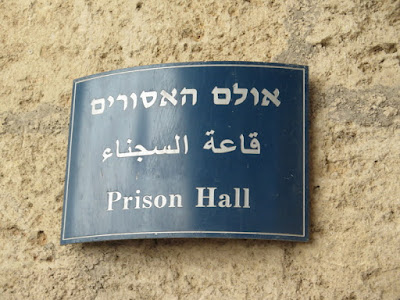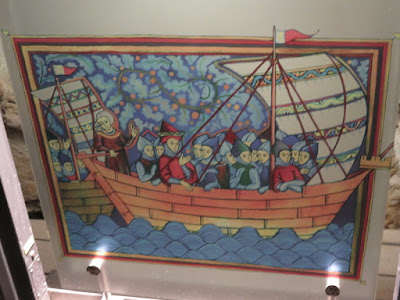Akko is one of the oldest inhabited sites in the world and has functioned as an important port during Canaanite, Old Testament, Roman, New Testament and Crusader eras. The city occupies an important location as it sits on the coast of the Mediterranean and links the waterways and commercial activities.
 Photo: Mosque of Ahmed Pasha al-Jazzar.
Photo: Mosque of Ahmed Pasha al-Jazzar. This mosque used marble from Herod's palace in Caesarea.
vv
Akko is located near Haifa and provides one of the best natural harbors along Palestine's Mediterranean cost.

The name
Akko comes from a Greek word that means "healing" or "cure." The Crusaders in the 12th century called it Jean d'Acre.
Akko is the holiest city of the Bahá'í Faith and therefore gets many Baha'i pilgrims. It is a mixed city that includes Jews, Muslims, Christians and Baha'is.
From the Persian through the Roman eras, it was Palestine's main port. Herod (37 BC) and Vespasian (AD 70) launcehd their conquests from here. Paul stayed with Christians "brethen" in Ptolemais (Acts 21:7) on his way to Jerusalem just before being arrested. When it was captured by the Crusaders (1104), Akko became the Crusader capital and fortresses were built. Today the facility functions as a museum.

Prison Hall.
Photo: Roman glass jars found in the excavation.
Photo: Light show on wall.
Photo: As we walked through this structure, there was a life size light show of moving figures on the wall.
Beautiful murals were painted on the walls.
Photo: Dylan, JC student.
Photo: Roman pottery.
Photo: Dining hall explanation.
Photo: Arches in dining hall.
Photo: Dining hall.
An art show was on display.
Photo: Glass blower.
Photo: Excavation.
Photo: Dr. Muhlestein lecturing.
Photo: Students were challenged to a dueling match with Dr. Muhlestein. He surprised everyone with his ability to fence and we learned later he took a fencing class in college.
Photo: JT Carden, JC student.
Photo: Latrines.
The draining system in the compound was highly advanced and was used to empty rain water in the winter and to drain sewage from the entire compound. Thirty five stone-made seats were found in the latrine hall arranged in four rows. Lime was scattered on the floor and the seats drained into a large hall of similar size that was built below them and paved with stone. Those using the latrines attended to their personal hygiene by using grass and straw. Additional seats were found in the floor above; these were also drained through pipes that had been installed in the walls and descended to the lower hall.
Photo: Latrines.
Photo: Toilet seats.
We walked outside and through some markets on our way to see the Mediterranean Sea.
Photo: Dr. Whitchurch and students in the market.
Photo: There are always lots of sweets for sale at the markets.
Photo: Fresh fish at the market.
Photo: Market at Akko. Look closely and you will see the pot pipes used for smoking.
Photo: Woodshop.
Photo: Market scene.
Photo: Mediterranean Sea and the end of another wonderful day in Israel!
 Photo: Mosque of Ahmed Pasha al-Jazzar. This mosque used marble from Herod's palace in Caesarea.
vv
Akko is located near Haifa and provides one of the best natural harbors along Palestine's Mediterranean cost.
Photo: Mosque of Ahmed Pasha al-Jazzar. This mosque used marble from Herod's palace in Caesarea.
vv
Akko is located near Haifa and provides one of the best natural harbors along Palestine's Mediterranean cost.
 The name Akko comes from a Greek word that means "healing" or "cure." The Crusaders in the 12th century called it Jean d'Acre. Akko is the holiest city of the Bahá'í Faith and therefore gets many Baha'i pilgrims. It is a mixed city that includes Jews, Muslims, Christians and Baha'is.
From the Persian through the Roman eras, it was Palestine's main port. Herod (37 BC) and Vespasian (AD 70) launcehd their conquests from here. Paul stayed with Christians "brethen" in Ptolemais (Acts 21:7) on his way to Jerusalem just before being arrested. When it was captured by the Crusaders (1104), Akko became the Crusader capital and fortresses were built. Today the facility functions as a museum.
The inscription on this says: "On this site in the 12-13th century, towered the fortress of the Order of the Knights of the hospital of Saint John who were based in Akko until the Muslim conquest in 1291. Over the ruins of the fortress which was reconstructed by the Ottoman Turks in the 17th and 18th centuries, was built the Citadel (fortress) and Palace of the Governors of Akko. In the mid-19th century, the Ottoman authorities added here a large prison. Under the British Administration (1918 - 1948), these buildings served as government offices and were the largest prison in Palestine. Among those incarcerated were also the fighters of the Jewish underground. After the establishing of the state of Israel until 1985, part of the building complex housed as a mental hospital.
Photo: Prison Hall.
Photo: Roman glass jars found in the excavation.
Photo: Light show on wall.
Photo: As we walked through this structure, there was a life size light show of moving figures on the wall.
Beautiful murals were painted on the walls.
Photo: Dylan, JC student.
Photo: Roman pottery.
Photo: Dining hall explanation.
Photo: Arches in dining hall.
Photo: Dining hall.
An art show was on display.
Photo: Glass blower.
Photo: Excavation.
Photo: Dr. Muhlestein lecturing.
Photo: Students were challenged to a dueling match with Dr. Muhlestein. He surprised everyone with his ability to fence and we learned later he took a fencing class in college.
Photo: JT Carden, JC student.
Photo: Latrines.
The draining system in the compound was highly advanced and was used to empty rain water in the winter and to drain sewage from the entire compound. Thirty five stone-made seats were found in the latrine hall arranged in four rows. Lime was scattered on the floor and the seats drained into a large hall of similar size that was built below them and paved with stone. Those using the latrines attended to their personal hygiene by using grass and straw. Additional seats were found in the floor above; these were also drained through pipes that had been installed in the walls and descended to the lower hall.
Photo: Latrines.
Photo: Toilet seats.
We walked outside and through some markets on our way to see the Mediterranean Sea.
Photo: Dr. Whitchurch and students in the market.
Photo: There are always lots of sweets for sale at the markets.
Photo: Fresh fish at the market.
Photo: Market at Akko. Look closely and you will see the pot pipes used for smoking.
Photo: Woodshop.
Photo: Market scene.
Photo: Mediterranean Sea and the end of another wonderful day in Israel!
The name Akko comes from a Greek word that means "healing" or "cure." The Crusaders in the 12th century called it Jean d'Acre. Akko is the holiest city of the Bahá'í Faith and therefore gets many Baha'i pilgrims. It is a mixed city that includes Jews, Muslims, Christians and Baha'is.
From the Persian through the Roman eras, it was Palestine's main port. Herod (37 BC) and Vespasian (AD 70) launcehd their conquests from here. Paul stayed with Christians "brethen" in Ptolemais (Acts 21:7) on his way to Jerusalem just before being arrested. When it was captured by the Crusaders (1104), Akko became the Crusader capital and fortresses were built. Today the facility functions as a museum.
The inscription on this says: "On this site in the 12-13th century, towered the fortress of the Order of the Knights of the hospital of Saint John who were based in Akko until the Muslim conquest in 1291. Over the ruins of the fortress which was reconstructed by the Ottoman Turks in the 17th and 18th centuries, was built the Citadel (fortress) and Palace of the Governors of Akko. In the mid-19th century, the Ottoman authorities added here a large prison. Under the British Administration (1918 - 1948), these buildings served as government offices and were the largest prison in Palestine. Among those incarcerated were also the fighters of the Jewish underground. After the establishing of the state of Israel until 1985, part of the building complex housed as a mental hospital.
Photo: Prison Hall.
Photo: Roman glass jars found in the excavation.
Photo: Light show on wall.
Photo: As we walked through this structure, there was a life size light show of moving figures on the wall.
Beautiful murals were painted on the walls.
Photo: Dylan, JC student.
Photo: Roman pottery.
Photo: Dining hall explanation.
Photo: Arches in dining hall.
Photo: Dining hall.
An art show was on display.
Photo: Glass blower.
Photo: Excavation.
Photo: Dr. Muhlestein lecturing.
Photo: Students were challenged to a dueling match with Dr. Muhlestein. He surprised everyone with his ability to fence and we learned later he took a fencing class in college.
Photo: JT Carden, JC student.
Photo: Latrines.
The draining system in the compound was highly advanced and was used to empty rain water in the winter and to drain sewage from the entire compound. Thirty five stone-made seats were found in the latrine hall arranged in four rows. Lime was scattered on the floor and the seats drained into a large hall of similar size that was built below them and paved with stone. Those using the latrines attended to their personal hygiene by using grass and straw. Additional seats were found in the floor above; these were also drained through pipes that had been installed in the walls and descended to the lower hall.
Photo: Latrines.
Photo: Toilet seats.
We walked outside and through some markets on our way to see the Mediterranean Sea.
Photo: Dr. Whitchurch and students in the market.
Photo: There are always lots of sweets for sale at the markets.
Photo: Fresh fish at the market.
Photo: Market at Akko. Look closely and you will see the pot pipes used for smoking.
Photo: Woodshop.
Photo: Market scene.
Photo: Mediterranean Sea and the end of another wonderful day in Israel!


















































No comments:
Post a Comment